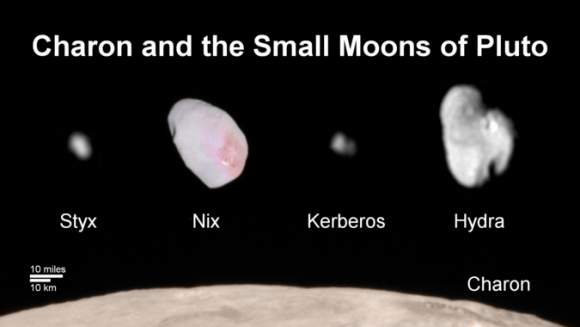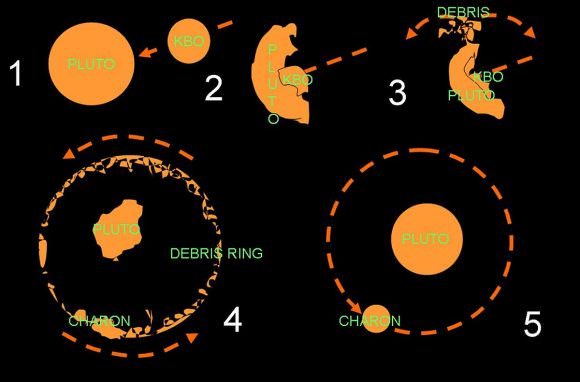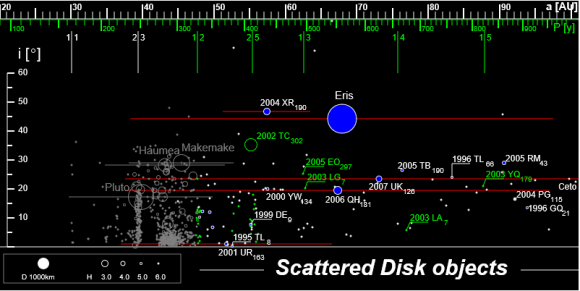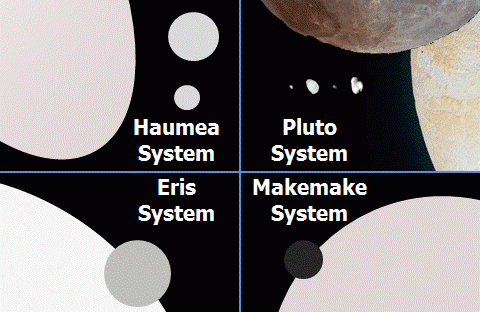The dwarf planets in our Solar System are some of the most interesting objects around. Of course, all of the Solar System objects–and anything in nature, really–are fascinating when you really focus on them. Now, a new study puts the focus squarely on the dwarf planet Haumea, and deepens the mystery surrounding its origins.
Dwarf planets Pluto and Haumea are considered cousins. Both of them, and their respective moons, are thought to be collisional families. This means they have a common origin in the form of an impact event. But the study, from Luke D. Burkhart, Darin Ragozzine, and Michael E. Brown, shows that Haumea doesn’t have the same kinds of moons as Pluto, which has astronomers puzzling over Haumea’s origins.
Pluto and Haumea are the only two bodies in the outer Solar System that have more than one Moon. Pluto has five moons (Charon, Styx, Nix, Kerberos, and Hydra) while Haumea has two moons, Hi’iaka and Namaka. Haumea is also the parent of a number of icy bodies which were parts of its surface, but now orbit the Sun on their own. The two other dwarf planets in the Kuiper Belt, Eris and Makemake, each have only one moon.

One thing that differentiates Haumea from Pluto is Haumea’s family of small icy bodies that came from its surface. While Pluto has a number of small icy moons, Haumea’s icy bodies orbit the Sun independently, and are not moons. Other properties of Haumea, like its inordinately high rate of spin, make Haumea a very interesting object to study. They also differentiate Haumea from Pluto, and are leading to questions about the cousin relationship between the two. If they are indeed cousins, then shouldn’t they share the same formation method?

Haumea’s lack of icy moons similar to Pluto’s was noted by researcher Darin Ragozzine. “While we’ve known about Pluto’s and Haumea’s moons for years, we now know that Haumea does not share tiny moons like Pluto’s, increasing our understanding of this intriguing object,” Ragozzine said.
There are definite similarities between Pluto and Haumea, but this study suggests that the satellite systems of the icy cousins, or former cousins, formed differently. “There is no self-consistent formation hypothesis for either set of satellites,” said Ragozzine.
Two things were at the heart of this new study. The first is the workhorse Hubble Space Telescope. In 2010, the Hubble focussed on Haumea, and captured 10 consecutive orbits to try to understand its family of satellites better.
The second thing at the heart of the study is called a “non-linear shift and stack method.” This is a novel technique which allows the detection of extremely faint and distant objects. When used in this study, it specifically ruled out the existence of small moons like the ones that orbit Pluto. This method may allow for future detection of other moons and Kuiper Belt Objects.
The study itself outlines some of Haumea’s properties that make it such an object of fascination for astronomers. It’s the fastest-rotating large body in the Solar System. In fact it rotates so quickly, that it’s near the rate at which the dwarf planet would break up. Haumea also has an unexpectedly high density, and a high albedo resulting from a surface of water ice. It’s two moons are in dynamically excited orbits, and its family of icy fragments is not near as dispersed as it should be. As the paper says, “There is no simple high-probability formation scenario that naturally explains all of these observational constraints.”
In the paper, the authors emphasize the puzzling nature of Haumea’s formation. To quote the paper, “Though multiple explanations and variations have been proposed, none have adequately and self-consistently explained all of the unique features of this interesting system and its family.”

Some of the explanations proposed in other studies include a collision between objects in the scattered disk, which overlaps the Kuiper Belt and extends much further, rather than objects in the Kuiper Belt itself. Another proposes that Haumea’s two largest moons–Hi’iaka and Namaka–are themselves second generation moons formed from the breakup of a progenitor moon.
Though the study shows that the Pluto system and the Haumea system, erstwhile cousins in the Solar System, have followed different pathways to formation, it also concludes that a collision was indeed the main event for both dwarf planets. But what happened after that collision, and where exactly those collisions took place, are still intriguing questions.


3……., 2……, 1……., And let the self-indulgent blathering over semantics commence!
No Jeff.. No takers yet.. A bit echoey in the echo chamber of Jeff’s Opinion Nation… ;P
Ps. No hard feelings. Just because we disagree on something we both still love the science of nature I can observe.. And who isnt self indulgent at times?
Should say “known moons”, because the more distant worlds might have some satellites to small to have been discovered yet. For instance, if Eris had a Kerberos analogue orbiting it, that moon would probably be too faint for even Hubble to see it even with the new stacking technique.
Nice to see some humility in the admission that formation methods and possible scenarios are not well understood for TNOs and KBOs. Now if we could see a similar admission that we dont have a really hard definition of what a planet is then we will be heading somewhere. Yes go ahead and say I am obsessing over semantics. Guilty as charged.
The International Weazely Astronomy Union (IWAU) hereby submits to the world through this good and democratic forum that henceforth and forthwith, the Solar System of Sol shall no longer contain Planets, being a contentious term, which shall be hereby be referred to as Planetoids. There shall be recognized, from this Day forth, 13+ Planetoids and growing (as per http://www.universetoday.com/15568/how-many-planets-are-in-the-solar-system/)
All in favor say ‘aeye.’ Ratified! Objections?? Brown, Beuller, Anyone????